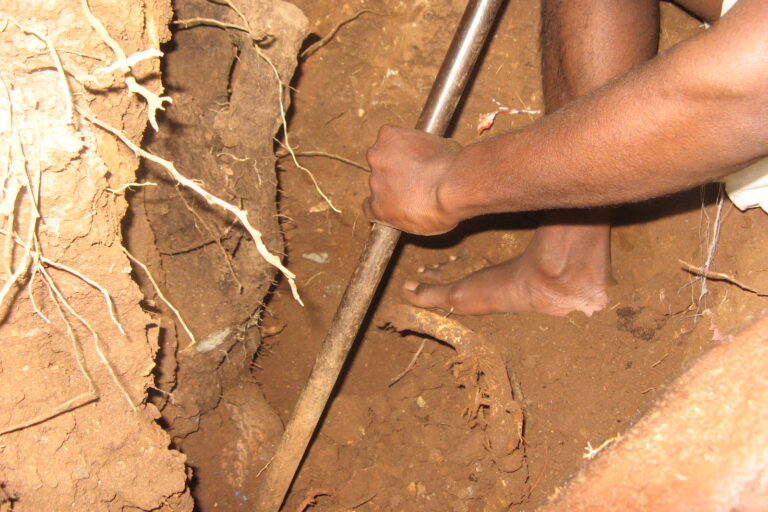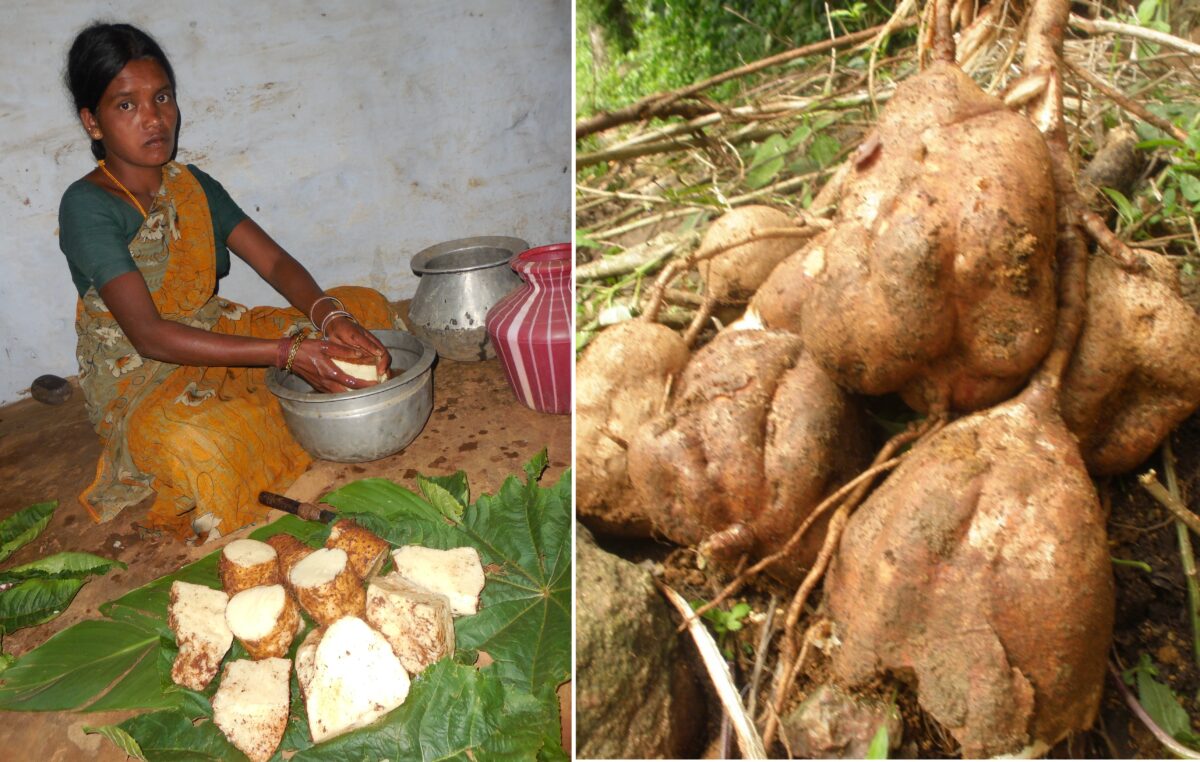
- Forest tubers are a resilient food source for the Irula community and are vital for food security, nutrition, and medicine. Gathering and propagation of these tubers are rooted in traditional ecological knowledge.
- Changing weather patterns and farming and lifestyles are eroding the Irulas’ regular foraging habits and weakening the transfer of tuber-related knowledge to younger generations.
- Irula elders express concern that ecological changes, social disruptions, and loss of socio-cultural norms could undermine the community’s food systems, crop diversity, and cultural practices.
Indigenous communities have long been at the frontline of the climate crisis. This is evident in the Nilgiris district of Tamil Nadu which is home to all six tribal groups in the state. Climate uncertainties are compounding pressures on their forest-based livelihoods, though intergenerational knowledge of food and medicine continues to sustain their resilience through environmental shifts.
Among uncultivated edibles, tubers stand out for their resilience to climate variability. Recognised for their climate resilience, tubers remain vital to indigenous and local food systems. As broader agricultural cycles grow unpredictable, the Irulas continue to forage and propagate tubers through traditional methods, making them one of the few reliable staples in an increasingly unstable food basket.
The Irula experiences in Semmanarai village offer insights into how communities are adapting to climate change, by negotiating shifts in forest dependence and food systems, while actively safeguarding traditional ecological knowledge and wild food practices.
A visit to Semmanarai, a village in the Kotagiri block of the Nilgiris district, helps understand contemporary shifts in Irula forest dependence and food systems.
Flanked by two Alu Kurumba hamlets, Semmanarai village is predominantly an Irula settlement. The village community of nearly 750 people, is divided into 16 Irula hamlets, apart from the two Alu Kurumba hamlets. The Irula community, a Particularly Vulnerable Tribal Group (PVTG) recognised as a sub-category under the Scheduled Tribe (ST) classification, faces growing ecological and cultural disruptions despite protections for their traditional habitats.
Surrounded by dense forests, the residents of Semmanarai depend on minor forest produce and traditional agriculture, called Thenai Kaadu in Irula — a mixed cropping practice with millets, vegetables, tubers and greens. More recently, they have been growing cash crops to meet their subsistence and livelihood needs.

Unraveling tuber tales
The Irulas call tubers Kangu in Kotagiri and Kisangu in certain other regions. The community identifies many types of tubers with distinct uses and gathering methods. While many are classified under the genus Dioscorea in Latin taxonomy, the Irulas recognise more variants than those distinguished by Western science.
Gathering tubers is not considered formal labour and is often done alongside other forest collections or when villagers graze their cattle or when they go into the forest to worship their gods or ancestors. Women and men both undertake this.
Tubers such as Nure Kangu and Reya Kangu are seasonal, available during the non-farming months from November to April, and play a crucial role in the Irula food system. Traditionally, grain farming took place from May to November, and these tubers ensured dietary continuity when millets were scarce. Kooge Kangu appears only once in a few years, while others like Neermuthi, Seeve, Makali, Koda, Velatha, Natta, and Kuchchi Kangu are available year-round. “We did not get any rice in those days, so we used vegetables, tubers, etc. from the forests as food,” recalls Rami, a resident of Semmanarai.
Seeve Kangu, found beneath broom grass, is prized for its nutritional and medicinal value. Dhoothi Kangu is collected from the spiral core of dead Koonthappannai trees and consumed as food. Koda Kangu’s flower, Senganthal Malar, the state flower of Tamil Nadu, marks its cultural and medicinal significance.
White-skinned Nure and black-skinned Reya tubers are commonly collected for food. The Irulas share certain beliefs around tuber gathering, including a local idiom: Kani Kangadu, which means “We get tubers like the people we see when we wake up.” Seeing someone in black signals Nure tubers while white suggests Reya. If you see heavily built people, you’re most likely to get large tubers, and thin people foretell slender ones.
Rami Amma recalls that in earlier times, a digging tool called a vasi was whittled from sturdy forest trees and used to unearth tubers. Today, this has been replaced by iron rods.
The gathering of tubers is closely tied to intricate knowledge of the forest and plant behaviour. For example, the vine of the Nure Kangu has thorns and often hangs from trees. The Irulas know it is time to harvest the tuber when its vines and leaves dry up. The Irula language contains specific words for techniques and practices related to tuber harvesting, reflecting sustainable foraging traditions.

Planting to foraging
The Irula community holds a deep reservoir of traditional knowledge on planting, harvesting, and sustainably managing forest tubers. In a kuyya kui, or a newly dug site, they know the harvest will be small. Larger yields are expected from holes dug the previous year. During harvest, Irula women replant the gaendae — the section between the stem and root — which then sprouts multiple roots, ensuring continuous annual harvests.
Community members shared several examples of this intricate knowledge system. The Irula have developed specific techniques for managing, harvesting, and sustaining tuber diversity, always mindful of ecological balance and health considerations.
While Reya and Nure Kangu are propagated by replanting the gaendae, other tubers follow different methods. For Kuchi Kangu, small sections of the kuchi (stem) are planted. Velatha Kangu is propagated by inserting its vine directly into the soil, coiled like a simmadu —the traditional headpad used to carry water pots. The vine later spreads, sprouts, and flowers. Cracked soil signals tuber maturity. Natta Kangu, on the other hand, is grown by planting the kakku, the fibrous, inedible section below the stem. Though it doesn’t cook well, it is placed at the bottom of the pot during cooking to prevent the edible parts from burning. Tubers like Koogei and Sembu require mature tubers themselves to be replanted.
The Irula also observe specific precautions in tuber propagation. They avoid replanting near the Saape (dead tuber), as dead tubers tend to stay attached to new growth, stunting the development of healthy tubers. Regular harvesting is encouraged to prevent new tubers from growing alongside old, decaying ones.
Through these practices, the Irula community continues to nurture a relationship with the forest, where foraging and farming are intimately connected to ecological knowledge, healthcare traditions, and cultural identity. However, market dynamics are beginning to shift these associations.

Continuity and change
The practice of gathering tubers has been jeopardised in recent years by various local challenges. Rami Amma and Velle Amma are concerned that younger generations are gradually losing touch with these nuanced practices. They believe that continuing the practice of consuming tubers is critical for sustenance and for cultural continuity. Children learn by observing and participating in the collection, preparation, and cultivation of these foods.
Read more: Traditional foods return with demand for local, seasonal produce
Snehlata Nath, founder director at Keystone Foundation, and a grassroots champion of eco-development and sustainable livelihoods with Irula communities says, “Traditional farming of millets has reduced due to changing weather patterns and uncertainty of rains. Social cohesion that was needed to ward off wild animals from damaging crops has also reduced. A simultaneous increase in negative wildlife interactions, especially with the elephant have resulted in a fear amongst them to enter the forest. Wage work is something communities fall back on for their livelihoods, which means daily or weekly commute to towns for work. This is resulting in furthering the alienation of the people from forest foraging,” she notes.
The reducing dependence on forest-based diets and shifts in land use have had a palpable impact on the natural ecosystems and availability of wild food. Velle amma, reflected on this, saying: “As a result of not following the socio-cultural norms properly, wild animals damage agricultural lands.” Many men from the village now migrate to nearby towns and cities like Kotagiri, Mettupalayam, and Coimbatore for work. This has made it difficult for women to forage, as they often cannot go into the forest alone due to the risk of wildlife encounters.
The shift to cooking with gas cylinders has also reduced the need to collect firewood, further limiting the regular practice of foraging for tubers. Kali, another Irula elder, notes that after the monsoon rains, tuber vines, leafy greens, and other plants would sprout naturally in these fields. “Mid-May rain was the ideal time in which new tubers would sprout. However, with changing rain cycles, the decline of these traditional farming methods and the current ban on burning agricultural forests, the sprouting of tuber vines has become less common in the mid-May season,” Kali says.
While changing life conditions have affected the Irula practice of foraging and eating tubers, this tradition persists in Semmanarai. The forest still provides for the people, who in turn safeguard it, ensuring tubers remain abundant. During crises such as the COVID-19 pandemic, when urban areas faced food shortages, the Irulas relied on forest greens and tubers.
Yet questions remain: will younger generations eat Nure or Reya Kangu, or remember their medicinal uses? Velle Amma’s concerns reflect a wider sentiment that ecological and social imbalances could alter their food systems and way of life. Her reflection on “not following socio-cultural norms” raises a deeper question of continuity — how these changes will shape daily life and the future of traditional knowledge.
This series is published in collaboration with Keystone Foundation and the stories are written by the members of the indigenous communities of the Nilgiris Biosphere Reserve.
Banner image: Tubers on display at the Nilgiris Earth Festival, along with other locally grown produce. Image by Anokha Venugopal/Keystone Foundation.



















































































































































































































































































































































































































































































































